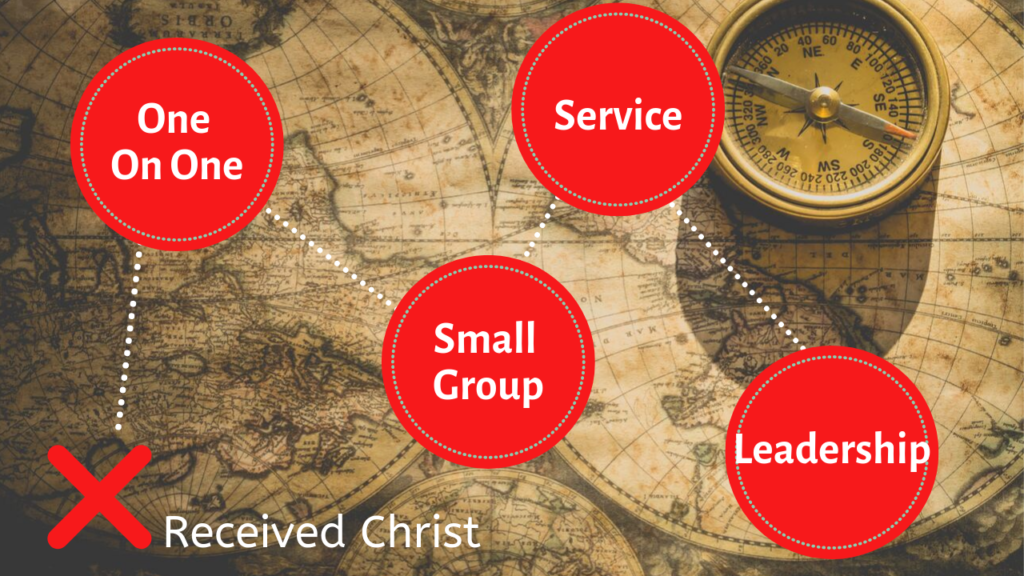This is part six in my seven part series on how to keep your youth ministry from collapsing. You can read from the beginning here.
Without discipleship, the church is a halfway house for repeat offenders. That’s a strong statement, but I stand behind it. I’ve worked in enough churches that were unintentional in their discipleship, and I saw them fall apart. The worse thing about it, the many people who came to Christ were left to spiritually fend for themselves. “Go Sunday school” and “Come to church” are not a discipleship strategy, it’s laziness.
How do we turn this around? When students come to Christ in your youth ministry, you need a few things to help that student out. These students need starting points and options.
Students need,
A clear call to follow Jesus
This is where it starts. I believe that if ask a group of kids to pray a prayer and receive Christ that is different than a call to follow Jesus. In your mind it may be the same, to a new student who does not understand church or the bible, there are no expectations with praying a prayer.
A conversation about what just happened
This step is so simple but is so overlooked in big and small groups alike. Many youth workers may think that once a prayer is prayed that kids are just suppose to fall in line and then are shocked when drift away.
Talking though their commitment and asking them key question like
- do you understand what I was asking for during the commitment time?
- Do you have any questions?
- Can we set up a time to talk next week about next steps?
- Can I give you our “map” for growth?
These are all permission based questions. Questions like these opens the door to finding out if the student is really interested in following Jesus or they just needed some prayer time or attention.
A map
No teenager follows directions exactly, unless it’s their personality to do so, but even so, teens need a map to know how to grow in their faith. Yes, their going to go all over the map, but if they get lost, at least they know how to get back to a starting point or a next phase or whatever your youth ministry has structured.
Your youth ministry’s map may look like the one below. Each of these are important locations but none of the are destinations. They are weigh points that teens move in and out of. Our role is to make sure these new followers of Christ, know how to maneuver between all of these as they grow.

In my opinion, new believing students need one on one check-in’s often, to get plugged into a small group (more for relational reasons than educational), given opportunities to serve according to their gifts and talents all within six months.
An opportunity to invest in themselves
Part of the map above, probably during one one, needs to include something the new believer can work through themselves. This can be a physical resource you work through together with them, a youtube video playlist or/and a study bible. New believers won’t last long without wisdom and guidance from God’s word.
It behooves a disciple maker to teach new believers, as quickly as possible, how to grow themselves. This doesn’t mean that once a child learns to hold a spoon you quit making them food, it just means you help the process along by sharing the process for finding answers and not just giving them the answers.
A place to feel at home
This may be the most difficult to accomplish because, depending on the heart of your other students to welcome in new people, some kids won’t fit right away. The may be from a different background or area of town. They may have extreme struggles your other youth or their parents are ill equipped to handle.
You can offset the differences by getting your most loving students, of similar gender, to commit to welcoming this new believer every week for several weeks.
If you have small groups, make sure you talk to the small group leader about this students new decision to follow Christ and that he or she might need special attention.
None of this usually goes perfectly, but if that new students senses you are doing everything in your power to welcome them in to your faith community, that alone could keep them coming until the rest of your students catch up and get to know this student.
A chance to serve
How long does a student need to wait, after making a decision to follow Christ, before serving on a team or being invited to go to the homeless shelter to serve? Not long. In fact, other than the Apostle Paul, who was a really bad dude as Saul, I not read about anyone going through a spiritual incubation period.
Yes, if the student who recently made a decision for Christ has some personal, social or family issues, you should handle with care until both you and them are comfortable with certain kinds of service projects or serving opportunities. Otherwise, start small and give them milk until they can handle meat, but don’t hold them back too long, otherwise they’ll become discouraged, defeated and feel like they’re not as “worthy” as other students in the group.
The opportunity to lead
Leadership is a hope every youth pastor should have for their students and should create space for these new converts to do lead in small ways such as sharing their testimony, help organize a project, etc. without too much pressure for a new believer. Keep expectations fair and you’ll see a steady growth as long as the student’s heart is willing.
If students are not being discipled you only hurt your own youth ministry and ultimately the church you serve. If your attendance is consistently down, events are hit and miss and your youth ministry is lacking momentum, consider going back to the drawing board on your discipleship strategy.
If you need help with designing a strategy, I wrote a whole book on the subject called The Disciple Project: Raising Up A New Generation of Doers.
If you’re thinking you need some help in crafting your own strategy, you’re welcome to join the Ministry Minded Coaching Group I facilitate.
